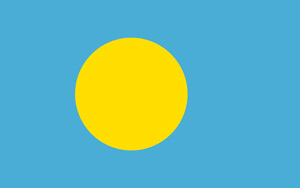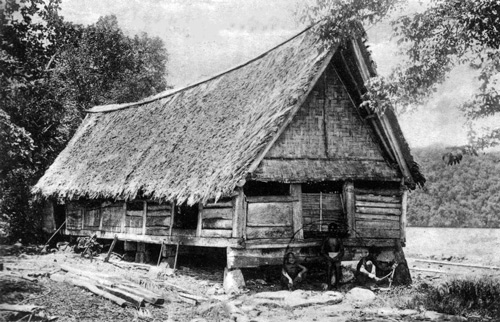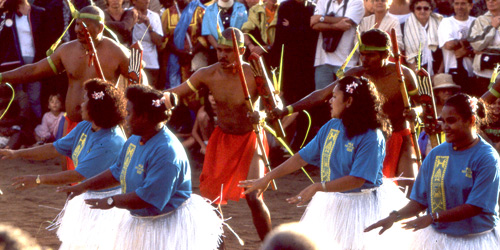Map
Flag

Quick facts
Official Name: Republic of Palau
Indigenous Peoples: Palauan (Belauan)
Official Languages: Palauan (Belauan), English (except for two states, Sonsorol and Hatohobei, where the local languages are also official. Japanese is an official language in the State of Angaur)
Political Status: Independent, freely associated with the United States
Capital: Ngerulmud
Population: 17,948 (2015 est.)
Greeting: Alii
History and geography

Palau is an archipelago located in the western Pacific Ocean. It is the westernmost portion of the Caroline Islands in Micronesia. Its most populous islands are Angaur, Babeldaob, Koror and Peleliu. The latter three lie together within the same barrier reef, while Angaur is an oceanic island several miles to the south. About two-thirds of the population live on Koror.
The coral atoll of Kayangel is north of these islands, while the uninhabited Rock Islands (about 200 islands) are west of the main island group. A remote group of six islands, known as the Southwest Islands, some 375 mi (604 km) from the main islands, make up the states of Hatohobei and Sonsorol.
Palau is comprised of several cultures and languages. Ethnic Palauans predominate, inhabiting the main islands of the archipelago. Descendants of the Carolinian atolls, especially Ulithi, settled on Palau’s southern atolls of Hatohobei, Sonsorol, Fannah, Pulo Anna, and Merir.
The islands have a total land area of 191 sq mi (495 sq km). Palau is best known for its 70-mile-long (113-km-long) barrier reef which encloses spectacular coral reefs and a lagoon of approximately 560 sq mi (1,450 sq km) – a diver’s paradise.
Palau was first settled some 3,000 years ago. Not much is known of the early history of the islands, but it is clear the Palauans participated in the wide-ranging Micronesian trade system, with some interaction with Malay traders. In the 19th century Palau was loosely part of the Spanish Pacific. After the Spanish-American War in 1898, Palau was among the islands sold to Germany by Spain. In 1914 the islands were occupied by the Japanese, a control later confirmed as a League of Nations Class C Mandate. From 1909 until 1954, phosphate mining took place on Angaur, originally by the Germans, then the Japanese, and finally by Americans. Angaur, as well as Peleliu, are major World War II battle sites between Japanese and American forces. The US took possession of the islands from Japan in 1944, during the war after fierce fighting.
Starting in 1947, Palau was part of the United Nations Trust Territory of the Pacific Islands, under the administration of the US government. Palauans established their own constitutional government in 1981. While Palau wanted to have a free association political arrangement with the US, ratification of a Compact of Free Association was delayed by constitutional nuclear-free clauses, which required a 75% vote of the people. Palauans also feared US military land use.
Between 1983 and 1991 Palau conducted seven plebiscites and experienced escalating violence, including the assassination of the first elected president. After a three-year cooling-off period and clarifying statements by the US on the conditions under which the US military might be present on the islands, the compact was approved, the trusteeship terminated, and the nation formally recognized by the United Nations in 1994, marking Palau’s independence. Palau is known for its progressive environmental stance.
Tourism from Asia and from divers worldwide drive Palau’s economy. It is one of the wealthier Pacific Island states. Besides tourism, subsistence agriculture and fishing, along with financial assistance from the US, contribute to the economy.
Arts and culture

Palau is well known for its carved storyboards, jewelry, weaving, dance and traditional oratory. Carved wooden storyboards are a highly developed art form, primarily for sale to foreigners. Watercolors of traditional village scenes by the late Charlie Gibbons are highly prized.
Dancing, too, is a well-developed art form. Traditional dances are performed by village groups. The women’s dances are stately and performed by two lines of women, while the men’s line dances often include war stances and stick dances. Oratory is highly valued, with senior elders performing historical chants and pieces. In village meetings there are also informal theatrical skits and clowning in informal dancing. Contemporary Palauan music is composed and performed in nightclubs and on public occasions.
The Belau National Museum, which opened in 1955, was begun privately with strong local support.
